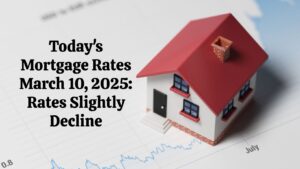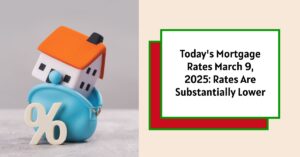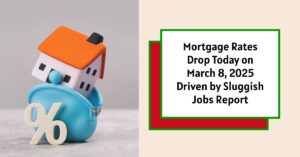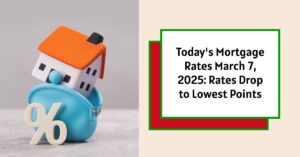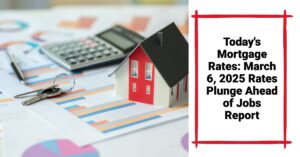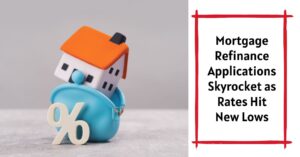As of today, March 13, 2025, mortgage rates have increased slightly in response to the latest inflation data, with the 30-year fixed mortgage rate now at 6.34% and the 15-year fixed rate at 5.65%. This uptick comes after weeks of declining rates, showing just how sensitive mortgage interest rates can be to shifts in economic conditions and consumer sentiment. Continuing economic improvements, as indicated by the latest Consumer Price Index (CPI) report, have contributed to the current trajectory of mortgage rates.
Today's Mortgage Rates March 13, 2025: Rates Rise in Response Inflation Data
Key Takeaways
- Current Mortgage Rates: 30-year fixed at 6.34% and 15-year fixed at 5.65%.
- Inflation Influence: Rates reacted to February's Consumer Price Index (CPI), which shows a year-over-year inflation increase of 2.8%.
- Refinance Rates: Today's refinance rates are slightly higher than purchase rates.
- Trends: The increase in rates reflects a recovering economy and rising consumer confidence, potentially impacting future home purchases and refinancing strategies.
Current Mortgage Rates
Understanding the variety of mortgage rates available today is crucial for both prospective home buyers and those considering refinancing their existing mortgage. Here's a detailed look at current averages from Zillow's data:
| Type of Mortgage | Interest Rate (%) |
|---|---|
| 30-year fixed | 6.34 |
| 20-year fixed | 6.11 |
| 15-year fixed | 5.65 |
| 5/1 ARM | 6.38 |
| 7/1 ARM | 6.79 |
| 30-year VA | 5.86 |
| 15-year VA | 5.28 |
| 5/1 VA | 5.76 |
As reflected in the table, the rates have progressed over the last few months. Notably, the 30-year fixed mortgage is widely recognized for its stability and robustness in the fluctuating financial environment. Conversely, the 5/1 ARMs are marketed with initial lower rates but can increase after five years, making them a gamble for borrowers who value budget predictability.
Today's Mortgage Refinance Rates
Refinancing your mortgage can lead to lower monthly payments and other advantages. Knowing current rates is essential for making informed financial decisions. Below are today’s average refinance rates:
| Refinance Type | Interest Rate (%) |
|---|---|
| 30-year fixed | 6.43 |
| 20-year fixed | 6.08 |
| 15-year fixed | 5.70 |
| 5/1 ARM | 6.89 |
| 7/1 ARM | 7.05 |
| 30-year VA | 5.91 |
| 15-year VA | 5.49 |
| 30-year FHA | 5.85 |
| 15-year FHA | 5.58 |
It's essential to note that refinance rates can sometimes be higher than those for purchasing a new mortgage, depending on individual circumstances and lender policies.
Understanding Mortgage Payments Today
For anyone contemplating taking out a mortgage or refinancing, understanding how interest rates impact monthly payments is vital. Below, we break down what you might expect to pay on various mortgage amounts based on today’s interest rates.
Monthly Payment on a $150,000 Mortgage
For a $150,000 mortgage at a 30-year fixed rate of 6.34%, your monthly payment would be approximately $932.59. Over the life of the loan, you would pay about $115,530 in interest. This scenario shows how even a manageable loan amount can build up considerable interest, which emphasizes the importance of securing the best possible rates.
Monthly Payment on a $200,000 Mortgage
Taking on a $200,000 mortgage at a 30-year fixed rate of 6.34%, your monthly payment would come to about $1,243.45. In total, you could end up paying approximately $154,042 in interest over the full mortgage period.
Monthly Payment on a $300,000 Mortgage
If you need to borrow $300,000 at a 6.34% fixed rate, expect your monthly payment to be around $1,865.17. Over 30 years, this translates to about $231,063 in interest costs.
Monthly Payment on a $400,000 Mortgage
For a higher-end mortgage of $400,000 at 6.34%, your monthly payment would be about $2,486.89, resulting in around $308,084 paid in interest throughout the loan term, clearly showing the financial commitment required.
Monthly Payment on a $500,000 Mortgage
Finally, if you’re looking at a $500,000 mortgage at 6.34%, your potential monthly payment would be around $3,108.62. Calculate approximately $385,105 in interest over the life of the loan.
Recommended Read:
Mortgage Rates Trends as of March 12, 2025
Mortgage Rates Drop: Can You Finally Afford a $400,000 Home?
Mortgage Rates Forecast March 2025: Will Rates Finally Drop?
Expect High Mortgage Rates Until 2026: Fannie Mae's 2-Year Forecast
How Mortgage Rates Work
Mortgage rates can seem intricate, but they simplify down to key principles. A mortgage interest rate represents the cost you incur for borrowing money from a lender, expressed as a percentage of the loan amount.
Types of Mortgage Rates
There are two main types of mortgage rates:
- Fixed-Rate Mortgages: These lock in your interest rate for the entirety of your loan period, making your monthly payments predictable and consistent.
- Adjustable-Rate Mortgages (ARMs): These start with lower rates than fixed-rate mortgages but will adjust to market conditions after a predetermined period.
While fixed-rate mortgages provide stability and protection against future rate increases, adjustable-rate mortgages can allow you to enjoy lower initial payments. However, the risk lies in potential rate increases, which can lead to higher payments after the introductory period ends.
The Amortization Cycle
When you first take out a mortgage, a substantial portion of your early payments go toward interest rather than paying down the principal. As time goes on, the balance shifts, and a larger portion of each payment goes toward reducing the principal. This illustrates how the amortization process works and emphasizes the costs involved.
Understanding Rate Determinants
Mortgage rates are significantly influenced by two categories of factors: those within your control and those that are not.
Factors You Can Control
- Credit Score: Generally, higher credit scores lead to lower interest rates.
- Debt-to-Income Ratio: Borrowers should keep their debt levels low to improve chances of securing better loan offers.
- Lender Comparison: Shopping around and comparing offers from different lenders can help you find the best rates available.
Factors You Cannot Control
- Economic Conditions: Rates typically rise when the economy is performing well since lenders anticipate more borrowing and spending. Conversely, if the economy is struggling, rates might fall.
- Inflation Rates: The impact of inflation directly affects mortgage rates; as inflation rises, lenders increase rates to maintain profitability.
Current Economic Context
The recently released CPI data for February 2025 indicates that inflation has increased by 2.8% year-over-year, which is lower than the 3% increase recorded in January 2025. These statistics can lead to increased consumer confidence but also higher mortgage rates, as lenders react to economic trends.
Understanding these dynamics can empower potential homeowners to navigate their mortgage decisions more effectively and with clarity.
Mortgage Types Explained
30-Year vs. 15-Year Fixed Mortgages:
- The 30-year mortgage is highly favored due to its lower monthly payment structure, making it more accessible for many people. However, this option usually comes with a higher interest rate, and borrowers end up paying far more interest over the long haul.
- In contrast, a 15-year mortgage typically carries a lower rate and allows homeowners to build equity faster. While the monthly payments are higher, it can result in substantial interest savings over time.
Conclusion
As we see rising mortgage rates reflective of improving economic conditions, it's essential for potential homebuyers or those considering refinancing to be proactive in understanding their options as well as the current market trends. The interplay between interest rates and economic indicators like inflation can greatly influence your home buying strategy, making being informed a crucial element of any purchasing decision.
Work With Norada, Your Trusted Source for
Real Estate Investments
With mortgage rates fluctuating, investing in turnkey real estate
can help you secure consistent returns.
Expand your portfolio confidently, even in a shifting interest rate environment.
Speak with our expert investment counselors (No Obligation):
(800) 611-3060
Recommended Read:
- Mortgage Rate Predictions 2025 from 4 Leading Housing Experts
- Mortgage Rates Forecast for the Next 3 Years: 2025 to 2027
- 30-Year Mortgage Rate Forecast for the Next 5 Years
- 15-Year Mortgage Rate Forecast for the Next 5 Years
- Why Are Mortgage Rates Going Up in 2025: Will Rates Drop?
- Why Are Mortgage Rates So High and Predictions for 2025
- Will Mortgage Rates Ever Be 3% Again in the Future?
- Mortgage Rates Predictions for Next 2 Years
- Mortgage Rate Predictions for Next 5 Years
- Mortgage Rate Predictions: Why 2% and 3% Rates are Out of Reach
- How Lower Mortgage Rates Can Save You Thousands?
- How to Get a Low Mortgage Interest Rate?
- Will Mortgage Rates Ever Be 4% Again?




